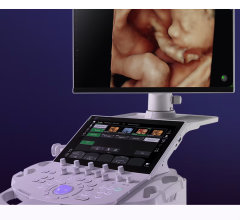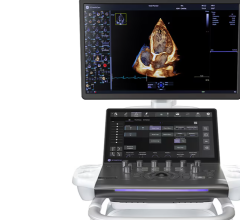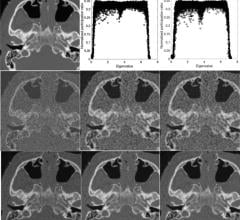April 27, 2007 - Parents-to-be might soon don 3-D glasses in the ultrasound lab to see their developing fetuses in the womb "in living 3-D, just like at the IMAX movies," according to researchers at Duke University's Pratt School of Engineering.
The same Duke team that first developed real-time, 3-D ultrasound imaging says it has now modified the commercial version of the scanner to produce an even more realistic perception of depth. Paired images seem to pop out of the screen when viewed with the special glasses.
(Watch the video, including paired images of both the cage and model fetus, at: You Tube. See if you can fuse them without goggles.)
The researchers created an updated version of the image-viewing software found on clinical ultrasound scanners, making it possible to achieve a stereo display with no additional hardware.
"To our knowledge, this is the first time it's been made possible to display real-time stereo image pairs on a clinical scanner," said Stephen Smith, a professor of biomedical engineering at Duke. "We believe all 3-D scanners could be modified in this way with only minor software changes."
The new imaging capability can improve the early diagnosis of certain kinds of birth defects of the face and skull and improve surgeons' depth perception during ultrasound-guided medical procedures, including tumor biopsies and robot-assisted surgeries done through tiny "keyhole" incisions.
The Duke team, which also includes Joanna Noble, an undergraduate student, and Matthew Fronheiser, a graduate student in Smith's laboratory, reported the findings in an issue of the journal Ultrasonic Imaging dated July 2006, but published in April 2007. The research was supported by the National Institutes of Health.
Human depth perception is largely the result of stereo vision -- the slightly different perspectives of the same scene that are observed by the left and right eyes, Smith said. The brain processes the information to produce a sense of depth, a phenomenon that can't be achieved when viewing a single, flat image.
Stereoscopic images solve that problem by taking two "snapshots" of the same object from slightly different angles, mimicking the normal difference between left and right eye views.
Special glasses or goggles can then be used to fuse the two images into one, gaining a 3-D effect. This principle lies behind 3-D movies and the familiar Fisher Price View-Master toy. With practice, some people can "defocus" their eyes and fuse the paired images without the aid of any special viewing device. (Find out how at http://en.wikipedia.org/wiki/Stereoscopy.)
To demonstrate the new capability, the researchers first generated stereo ultrasound images of a small metal cage. They then advanced to ultrasound images in living animals of a heart valve and blood vessels and needle biopsies of the animals' brains and esophagi.
The researchers have since recorded ultrasound images of a model human fetus that is traditionally used in the testing of fetal ultrasound imaging devices. (Watch the video, including paired images of both the cage and model fetus, at: You Tube. See if you can fuse them without goggles.)
"Thousands of 3-D ultrasound systems in clinics could be upgraded with such new software, and stereoscopic goggles could be issued to them as well," Smith said. "Keepsake DVDs of the fetal exam could also be viewed at home in 3-D stereo."
The goggles would soon become obsolete, he added. New monitors capable of fusing stereo 3-D images without them are now in development.
Contact: Kendall Morgan
Duke University
Source: Medical News Today


 November 03, 2025
November 03, 2025 









